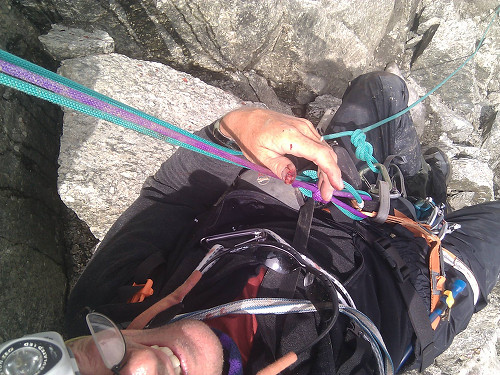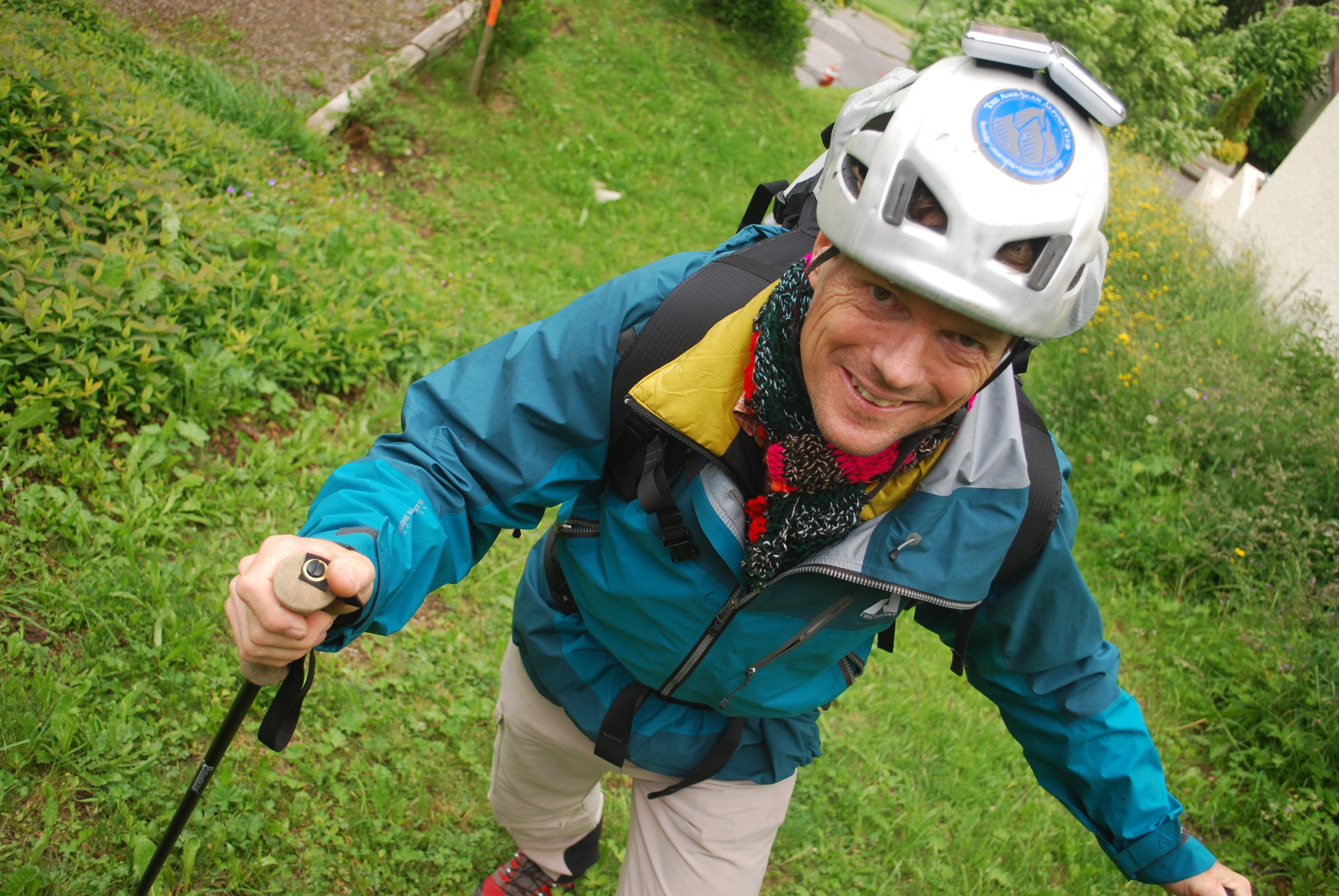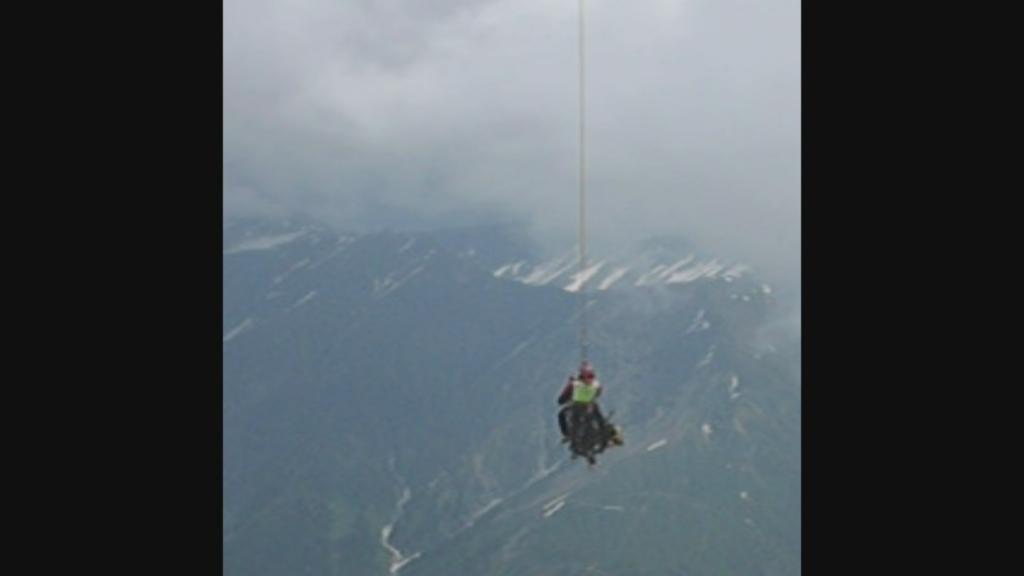Adventurer Harlin feels “very lucky”

Despite breaking bones in both feet in a near-fatal accident, mountaineer John Harlin tells swissinfo.ch he wants to complete his Swiss border adventure after his recovery.
The 54-year-old American was in good spirits on Friday after leaving hospital in Sion, especially considering he had fallen off a mountain the day before while climbing on the Swiss side of Aiguilles Rouges du Dolent in canton Valais.
Harlin had been attempting to trace the entire Swiss border under his own power in just three months.
swissinfo.ch: How do you feel?
John Harlin: I feel very fortunate that things turned out as well as they did. It could have been so much worse. Even though I have to stop the journey for some while and it’ll be awkward to get around with broken feet, I feel very lucky.
I feel very grateful that it happened on the Swiss side where there was telephone reception and we could call for rescue and there was good weather. And it could have been the other end of my body, which would’ve been much worse.
swissinfo.ch: What exactly happened?
J.H.: We got up at 3am on Thursday and climbed from the Argentière Glacier to reach the crest of a ridge at about 8am. But we discovered that the rock on the Swiss side was horribly rotten.
I put a piece of protection [next to a loose flake] and continued up, but when I touched the top it came out and the whole thing just pulled away, including my protection. I tumbled upside down and was bouncing down the rock.
After a 15-20 metre fall, the rope caught on the flake, which cut through the rope three quarters, and stopped me. At first I thought I was OK, as I was shocked, so I told [my climbing partner] Cam that we could rappel [abseil] down, but he said it was much too dangerous. Then I realised that my rib was broken and after a while I noticed that my feet were hurting and I couldn’t really stand on them, so I realised we had to call for a rescue.
swissinfo.ch: Have you analysed why you fell?
J.H.: I was being careful, but I relaxed too much as it was the first good rock we were on and I was climbing fast, so I didn’t pay attention to the fact that this block was loose.
So often it’s human error. I’ve had good fortune climbing on loose rock and I enjoy it as I think things will go well and they have. I trust my instincts. But things go wrong sometimes and that particular flake was just there ready to go wrong and I made it go wrong.
swissinfo.ch: Were you pushing too hard?
J.H.: On this particular section, which I thought would be the most dangerous, it was not possible to go around as I really wanted to get to the top of Mont Delont.
It’s significant as it’s where three borders come together – French, Italian and Swiss – and an important milestone of the journey. I wanted to get there and there is no easy way. I was willing to go after it rather than make a major detour. A clear case of ambition getting in the place of wisdom.
I very definitely underestimated the difficulty of the first part of the trip.
swissinfo.ch: Was the weather a factor?
J.H.: What we didn’t anticipate was that this year it was very wet in spring so there was lots of fresh snow. The day I arrived it was raining and there was snow low down that cleared up the day I started walking.
When we reached the high country, there was lots of loose snow and we broke through to our ankles. It was very laborious and dangerous as it’s loose and can avalanche.
If it had been a normal summer, much of that would have consolidated and we’d have had good secure conditions to walk on much faster. As it turns out, this year it was bad in June, but maybe it will be terrible in September too, you never know.
swissinfo.ch: What are the biggest lessons learnt from this incident?
J.H.: It’s a reminder of how much easier you think it will be sitting in front of your computer dreaming big.
You look at the map and say, ‘that’s only 2cm; I can do 2cm in a day’, and then you get there and reality slaps you in the face and you realise you’re not quite the hero you thought you were!
Just because I really want something doesn’t make it happen. I have to think and plan realistically.
swissinfo.ch: What about some of the positive memories?
J.H.: I didn’t fully realise how beautiful the section south of St Gingolph really is, especially the meadows and limestone cliffs and nature reserve. There were chamois and ibex everywhere.
It’s also wonderful to be able to share this experience via new technologies. It’s not my style – normally I just go out there and disappear.
swissinfo.ch: So what next?
J.H.: I don’t intend to let this stop me. I have to wear these modern cast contraptions for six weeks and then my feet should heal themselves. If I’m careful enough they said six weeks of gentle walking, then I can start the kayaking section in northern Switzerland, two weeks in a boat before walking the Schaffhausen section.
I can finish the Rhine part then go across the Jura, which is a bit rugged, but I can follow more trails, then back across Lake Geneva.
Instead of finishing in Leysin as intended, I’d like to come back in summer 2011 and hike the rest of the southern border.
I don’t get to do it in a continuous swoop which was important to me – but maybe [the accident] is a blessing in disguise, as it will reorient me to continue from a more cultural perspective, which is truer to what I really wanted to get out of this trip.


In compliance with the JTI standards
More: SWI swissinfo.ch certified by the Journalism Trust Initiative




You can find an overview of ongoing debates with our journalists here. Please join us!
If you want to start a conversation about a topic raised in this article or want to report factual errors, email us at english@swissinfo.ch.